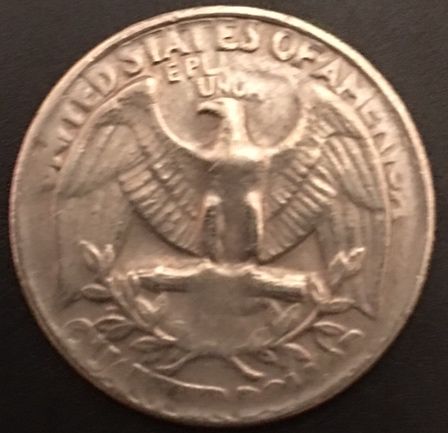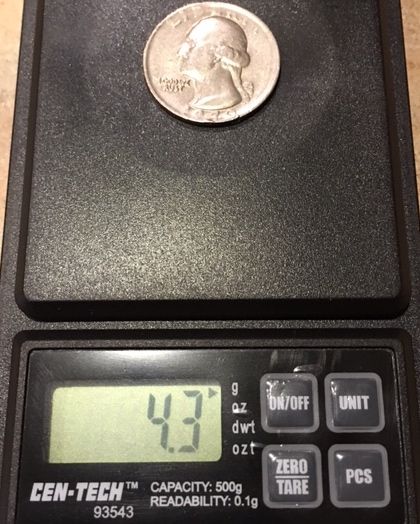Need help on this 1970 d Quarter
After seeing a fews recent threads on coins struck on incorrect planchets, I remembered a quarter I had
for over 20 years that seemed too light for being a quarter. So I went in to my baggies of mixed junk coins and found it.
After researching and seeing photos I've concluded it's a 1970 d quarter struck on 10 cent stock. But a dime should weigh 2.268 grams and my quarter weighs between 4.2 and 4.3 grams (my scale kept changing between the two numbers). My first question is am I correct in thinking that it's a quarter struck on 10 cent stock, and 2nd what's going on with the weight difference? Thank you in advance for any help you can provide.
Sorry about photos...best I can do.




for over 20 years that seemed too light for being a quarter. So I went in to my baggies of mixed junk coins and found it.
After researching and seeing photos I've concluded it's a 1970 d quarter struck on 10 cent stock. But a dime should weigh 2.268 grams and my quarter weighs between 4.2 and 4.3 grams (my scale kept changing between the two numbers). My first question is am I correct in thinking that it's a quarter struck on 10 cent stock, and 2nd what's going on with the weight difference? Thank you in advance for any help you can provide.
Sorry about photos...best I can do.




BST transactions - Wondercoin, SNMAN , Mb423, Timbuk3
0
Comments
However, your coin is too heavy to be struck on dime stock. It is probably struck on a rolled thin planchet.
Edited to correct a wrong assumption on my part.
A clad dime punched from dime stock weighs 2.27 grams. Multiply that by 1.83 times the area and you get a theoretical weight for a dime-stock clad quarter of 4.1541 grams.
As Mike says it is a bit heavy for that theoretical value, but I do not know how accurate your scale it. It is close enough that I would call it a dime-stock quarter.
TD
If you take the area of a struck dime (251.93 sq. mm) and divide that into the area of a struck quarter (461.48 sq. mm), a struck quarter has approx. 1.83 times the area of a struck dime. (The diameters of type one dime and quarter blanks might be slightly different than the diameters of struck coins, but I do not have those diameters.)
A clad dime punched from dime stock weighs 2.27 grams. Multiply that by 1.83 times the area and you get a theoretical weight for a dime-stock clad quarter of 4.1541 grams.
As Mike says it is a bit heavy for that theoretical value, but I do not know how accurate your scale it. It is close enough that I would call it a dime-stock quarter.
TD
And I thought I was good with Math. My scale is a cheapie $7 Harbor Freight special but it does what I need it to do. After Mike cleared things up for me I placed the quarter next to a dime and sure enough looking through a 10x loop they are equal in thickness. Thanks Capt.
Interesting enough, it has a type G reverse which is not the usual 1970 D quarter reverse (unless you are working with mint sets or buying from a dealer).
This reverse was one made for and in 1968 only used for proof sets. The lower eagle wing segments have a high relief to the field. This reverse only appears on certain 1968 S, 1969 D, 1970 D and 1970 Philly quarters. I have seen other dime stock 1970 D quarters with this reverse.o
Incidentaly, it was San Francisco that punched out the wrong planchets. Things San Francisco could not used was sent to Denver for their use. They were not pleased with this contribution.
This is a well known error. It is mentioned in a footnote in the Red Book.
Interesting enough, it has a type G reverse which is not the usual 1970 D quarter reverse (unless you are working with mint sets or buying from a dealer).
This reverse was one made for and in 1968 only used for proof sets. The lower eagle wing segments have a high relief to the field. This reverse only appears on certain 1968 S, 1969 D, 1970 D and 1970 Philly quarters. I have seen other dime stock 1970 D quarters with this reverse.o
Incidentaly, it was San Francisco that punched out the wrong planchets. Things San Francisco could not used was sent to Denver for their use. They were not pleased with this contribution.
I never knew that they were made in 'Frisco. I did know that they typically sent their reject Proof planchets to Denver to be struck as regular coinage.
I presume San Francisco was the source of the type H quarter reverse dies used on a very few 1969 D thru 1972 D quarters.
I also think SF was the source of the 1969 D type G reverse dies. 1970 's were another story as the mint seem to use them interchangablely even making over 100 class III double dies (G/F). In general these were not very spectacular.
In my original post I said the numbers on my scale kept changing. It was driving me nuts until I realized the air from the ceiling fan was the cause.
It turns out my cheapie scale works pretty good after all.